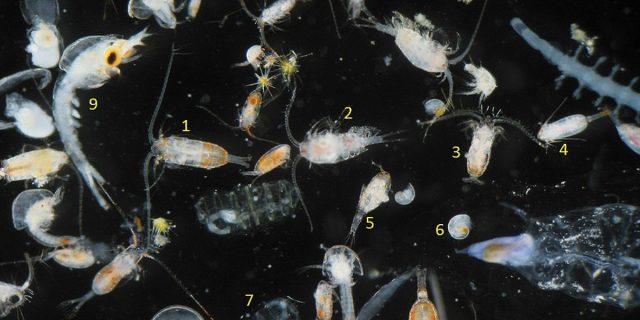15
Sep
Studies Show How Pesticides Harm Organisms that Form the Foundation of Freshwater Ecosystems

(Beyond Pesticides, September 15, 2021) Toxic pesticide use, and glyphosate in particular, degrades the health of freshwater ecosystems by harming species that form the basis of aquatic food chains, according to research published by scientists at McGill University. In a series of studies, scientists investigated how freshwater bacteria and zooplankton were affected by varying levels the weed killer glyphosate, the neonicotinoid insecticide imidacloprid, and nutrient levels. “Because plankton form the foundation of the food chain in freshwater ecosystems, it is very important to understand how plankton communities respond to widely used pesticides,” said Jesse Shapiro, PhD, an Associate Professor in McGill’s Department of Microbiology and Immunology. “Our research shows that the structure of these communities can be impaired under currently acceptable North American water quality guidelines.”
Two separate experiments were conducted under similar conditions in order to properly investigate the effects of pesticide exposure on either zooplankton or freshwater bacteria. For both studies, target species were exposed to varying rates of glyphosate, imidacloprid, or both chemicals at either high or low water nutrient levels. Researchers conducted this study by establishing a series of outdoor experimental ponds, intended to mimic freshwater ecosystems by using Lake water and evenly distributing organisms throughout the ponds.
Zooplankton were found to be much more sensitive to pesticide exposure than freshwater bacteria. However, glyphosate was found to be the most damaging exposure within both experiments. “We found that when we applied the pesticides and fertilizers alone and in combination, at a wide range of concentrations, that glyphosate was the most influential driver of community structure among the agrochemicals,” said Andrew Gonzalez, PhD, a professor in McGill’s Biology Department and the Liber Ero Chair in Biodiversity Conservation.
In the zooplankton study, low levels (.3 parts per million) of glyphosate resulted in persistent declines in rotifer populations, while both pesticides harmed populations of copepod crustaceans (at 3 parts per billion with imidacloprid and 5.5 parts per million with glyphosate). At higher, yet still environmental relevant rates, scientists observed synergy between the two pesticides that resulted in significant declines in overall zooplankton biomass.
In both studies, pesticide use drove changes in community structure. In the bacterial study, glyphosate use at its highest dose (15 ppm) altered the community structure over the long term. Initial reductions in biomass recovered over a 24 day period, but shifted slightly in favor of bacteria that were able to flourish in the presence of glyphosate. “We believe that they were able to recover because they came from a pristine lake and the initial community was diverse enough to “buffer” such a large impact,” said Naila Barbosa da Costa, a PhD student in Biology at l’Université de Montréal. “We do not know if bacterial communities from less diverse ecosystems would be able to cope with a strong contamination the same way.”
Zooplankton populations experienced a more damaging long-term shift. Glyphosate-exposed zooplankton exhibited a fast knockdown, and many species that were killed off in the initial exposure did not return. Eventually, biomass recovered, but the diversity of species was much lower than before. Glyphosate killed off a range of diverse sensitive species, allowing a small subset of glyphosate-tolerant species to thrive. “Long-lasting species loss and compositional shifts have clear implications for the functioning and stability of freshwater ecosystems, even when zooplankton abundance appears unaffected,” said Marie-Pier Hébert, a PhD candidate in McGill’s Department of Biology. “How the effects of glyphosate cascade through freshwater ecosystems to affect their health in the long-term deserves much more study.”
Previous research has shown a range of nontarget effects from glyphosate that are not adequately captured by current pesticide regulations in the United States. Previous research from McGill University on phytoplankton found similar results; communities were able to withstand glyphosate exposure, but diversity ultimately declined as a result. A study published earlier this year from UK researchers found that a specific zooplankton, the water flea Daphnia spp, experiences genotoxic damage that harms its fitness in the wild, a danger not considered by current pesticide toxicity testing undertaken by regulatory agencies around the world.
The neonicotinoid imidacloprid has also been linked to the decline of freshwater ecosystems in previous research, and the findings of damage to copepod crustaceans line up well with studies showing significant threats to benthic organisms from the neonicotinoid insecticides.
Pesticides do not need to decimate species in order for ecosystems to degrade or become irreparably damaged. Subtle shifts in community composition and diversity can drive changes that ripple up and down food chains, as evidenced by emerging research on how pesticides cause trophic cascades.
The diet of weak poisons that humans and the ecosystems we rely upon continue to suffer through does not need to go on. Organic agriculture and land management provide the framework for an interaction between humans and the environment that does not seriously disrupt ecosystem functioning as a result of toxic chemical use. But even this approach is under threat from agrichemical industry interests that want to garner higher prices while sapping the core of what makes organic sustainable. Help make sure organic continues to lead the way in environmental and health protection by engaging with the National Organic Standards Board during the upcoming public comment period.
All unattributed positions and opinions in this piece are those of Beyond Pesticides.
Source: McGill University press release, Molecular Ecology, Ecological Applications










